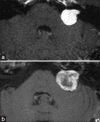Hydrocephalus after Gamma Knife Radiosurgery for Schwannoma
- PMID: 31143267
- PMCID: PMC6516019
- DOI: 10.4103/ajns.AJNS_278_18
Hydrocephalus after Gamma Knife Radiosurgery for Schwannoma
Abstract
Objective: Gamma Knife radiosurgery (GKRS) has been established as an effective and safe treatment for intracranial Schwannoma. However, communicating hydrocephalus can occur after GKRS. The risk factors of this disorder are not yet fully understood. The objective of the study was to assess potential risk factors for hydrocephalus after GKRS.
Methods: We retrospectively reviewed the medical radiosurgical records of 92 patients who underwent GKRS to treat intracranial Schwannoma and developed communicating hydrocephalus. The following parameters were analyzed as potential risk factors for hydrocephalus after GKRS: age, sex, target volume, irradiation dose, prior tumor resection, treatment technique, tumor enhancement pattern, and protein level of cerebrospinal fluid (CSF) after GKRS.
Results: Of the 92 patients, eight of them developed communicating hydrocephalus. Target volume and tumor enhancement pattern, and protein level of CSF ware associated with the development of hydrocephalus.
Conclusion: In particular, patients with intracranial Schwannomas with large tumor size, ring enhancement patterns, and high protein level of CSF should be carefully observed.
Keywords: Gamma knife radiosurgery; Schwannoma; hydrocephalus.
Conflict of interest statement
There are no conflicts of interest.
Figures


References
-
- Samii M, Matthies C. Management of 1000 vestibular schwannomas (acoustic neuromas): The facial nerve--preservation and restitution of function. Neurosurgery. 1997;40:684–94. - PubMed
-
- Park CK, Lee SH, Choi MK, Choi SK, Park BJ, Lim YJ, et al. Communicating hydrocephalus associated with intracranial schwannoma treated by gamma knife radiosurgery. World Neurosurg. 2016;89:593–600. - PubMed
-
- Flickinger JC, Kondziolka D, Niranjan A, Lunsford LD. Results of acoustic neuroma radiosurgery: An analysis of 5 years’ experience using current methods. J Neurosurg. 2001;94:1–6. - PubMed
-
- Hasegawa T, Kida Y, Kobayashi T, Yoshimoto M, Mori Y, Yoshida J, et al. Long-term outcomes in patients with vestibular schwannomas treated using gamma knife surgery: 10-year follow up. J Neurosurg. 2005;102:10–6. - PubMed
-
- Pollock BE, Foote RL, Stafford SL. Stereotactic radiosurgery: The preferred management for patients with nonvestibular schwannomas? Int J Radiat Oncol Biol Phys. 2002;52:1002–7. - PubMed

